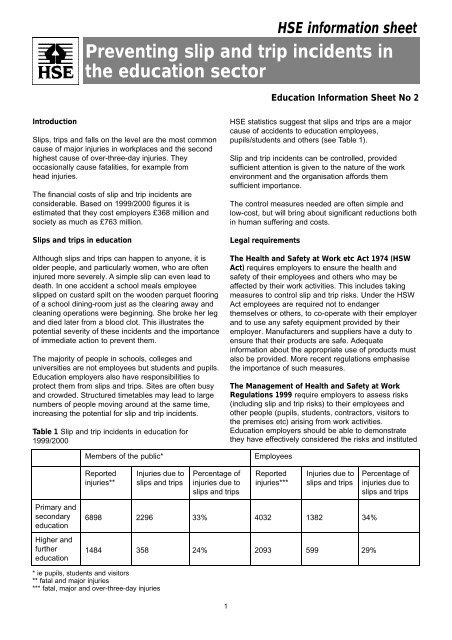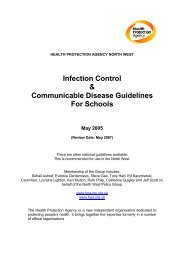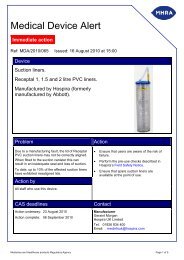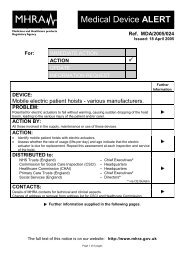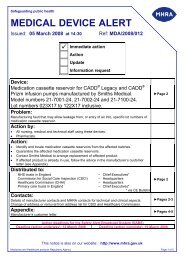Slips Trips And Falls - Hse Leaflet.pdf - Bolton LEA Website
Slips Trips And Falls - Hse Leaflet.pdf - Bolton LEA Website
Slips Trips And Falls - Hse Leaflet.pdf - Bolton LEA Website
You also want an ePaper? Increase the reach of your titles
YUMPU automatically turns print PDFs into web optimized ePapers that Google loves.
HSE information sheet<br />
Preventing slip and trip incidents in<br />
the education sector<br />
Education Information Sheet No 2<br />
Introduction<br />
<strong>Slips</strong>, trips and falls on the level are the most common<br />
cause of major injuries in workplaces and the second<br />
highest cause of over-three-day injuries. They<br />
occasionally cause fatalities, for example from<br />
head injuries.<br />
The financial costs of slip and trip incidents are<br />
considerable. Based on 1999/2000 figures it is<br />
estimated that they cost employers £368 million and<br />
society as much as £763 million.<br />
<strong>Slips</strong> and trips in education<br />
Although slips and trips can happen to anyone, it is<br />
older people, and particularly women, who are often<br />
injured more severely. A simple slip can even lead to<br />
death. In one accident a school meals employee<br />
slipped on custard spilt on the wooden parquet flooring<br />
of a school dining-room just as the clearing away and<br />
cleaning operations were beginning. She broke her leg<br />
and died later from a blood clot. This illustrates the<br />
potential severity of these incidents and the importance<br />
of immediate action to prevent them.<br />
The majority of people in schools, colleges and<br />
universities are not employees but students and pupils.<br />
Education employers also have responsibilities to<br />
protect them from slips and trips. Sites are often busy<br />
and crowded. Structured timetables may lead to large<br />
numbers of people moving around at the same time,<br />
increasing the potential for slip and trip incidents.<br />
Table 1 Slip and trip incidents in education for<br />
1999/2000<br />
Members of the public*<br />
HSE statistics suggest that slips and trips are a major<br />
cause of accidents to education employees,<br />
pupils/students and others (see Table 1).<br />
Slip and trip incidents can be controlled, provided<br />
sufficient attention is given to the nature of the work<br />
environment and the organisation affords them<br />
sufficient importance.<br />
The control measures needed are often simple and<br />
low-cost, but will bring about significant reductions both<br />
in human suffering and costs.<br />
Legal requirements<br />
The Health and Safety at Work etc Act 1974 (HSW<br />
Act) requires employers to ensure the health and<br />
safety of their employees and others who may be<br />
affected by their work activities. This includes taking<br />
measures to control slip and trip risks. Under the HSW<br />
Act employees are required not to endanger<br />
themselves or others, to co-operate with their employer<br />
and to use any safety equipment provided by their<br />
employer. Manufacturers and suppliers have a duty to<br />
ensure that their products are safe. Adequate<br />
information about the appropriate use of products must<br />
also be provided. More recent regulations emphasise<br />
the importance of such measures.<br />
The Management of Health and Safety at Work<br />
Regulations 1999 require employers to assess risks<br />
(including slip and trip risks) to their employees and<br />
other people (pupils, students, contractors, visitors to<br />
the premises etc) arising from work activities.<br />
Education employers should be able to demonstrate<br />
they have effectively considered the risks and instituted<br />
Employees<br />
Reported<br />
injuries**<br />
Injuries due to<br />
slips and trips<br />
Percentage of<br />
injuries due to<br />
slips and trips<br />
Reported<br />
injuries***<br />
Injuries due to<br />
slips and trips<br />
Percentage of<br />
injuries due to<br />
slips and trips<br />
Primary and<br />
secondary<br />
education<br />
6898<br />
2296<br />
33%<br />
4032<br />
1382<br />
34%<br />
Higher and<br />
further<br />
education<br />
1484<br />
358<br />
24%<br />
2093<br />
599<br />
29%<br />
* ie pupils, students and visitors<br />
** fatal and major injuries<br />
*** fatal, major and over-three-day injuries<br />
1
suitable control measures. They also need to ensure<br />
that the measures they have taken are effective. They<br />
should investigate any significant slip and trip incidents.<br />
Employees have a duty to report any situation that<br />
might present a serious and imminent danger and they<br />
should also notify employers of any shortcomings in the<br />
health and safety arrangements.<br />
The Workplace (Health, Safety and Welfare)<br />
Regulations 1992 contain requirements relating to the<br />
construction of floors and traffic routes and to the need<br />
to keep them clean and free of obstructions:<br />
A major refurbishment or new building work is an<br />
opportunity to eliminate slip and trip hazards. The work<br />
may be subject to the Construction (Design and<br />
Management) Regulations 1994 (CDM Regulations).<br />
Safety representatives appointed under the Safety<br />
Representatives and Safety Committees<br />
Regulations 1977 must be consulted on health and<br />
safety matters. They must also be given access to<br />
information relevant to the health and safety of the<br />
workers they represent, including any information<br />
relating to potentially hazardous conditions, such as<br />
slip and trip risks.<br />
The Health and Safety (Consultation with<br />
Employees) Regulations 1996 require employers to<br />
consult with workers, either directly or indirectly through<br />
elected representatives, on matters relating to their<br />
health and safety at work. Safety representatives can<br />
help employers with both the development and<br />
implementation of a slip and trip risks policy. They will<br />
be able to identify risks in the workplace and bring the<br />
workers’ perspective to the policy-making process.<br />
Developing and implementing a successful policy to<br />
control slip and trip risks will require the support of<br />
everyone including senior managers, employees,<br />
contractors and others.<br />
Schools and colleges may wish to take a ‘whole school’<br />
approach and also involve the pupils/students in<br />
practical discussions on the risks and how they can be<br />
controlled. They may also wish this approach to include<br />
disability issues that affect staff, pupils and visitors to<br />
the premises. Linking it to topics in the curriculum can<br />
form part of the process of educating pupils in risk<br />
awareness.<br />
Control measures<br />
In order to effectively control slip and trip risks,<br />
employers should:<br />
●<br />
●<br />
identify the hazards – look for slip and trip hazards<br />
around the site;<br />
decide who might be harmed and how – look at<br />
who comes onto the site, and whether they are at<br />
risk;<br />
●<br />
●<br />
●<br />
consider the risks and decide if precautions<br />
already being taken are enough or if more needs<br />
to be done;<br />
record the findings;<br />
review the assessment regularly and revise it if<br />
necessary.<br />
Education premises are varied and often complex sites.<br />
The measures to be taken to control the risks will vary<br />
according to the different areas of the site and the<br />
different activities being undertaken. Each will need to<br />
be assessed separately and a range of practical<br />
measures adopted to control the risk depending on the<br />
assessment.<br />
The risk factors to consider include:<br />
●<br />
●<br />
●<br />
●<br />
●<br />
environmental (floor, steps, slopes etc);<br />
contamination ( water, food, litter etc);<br />
organisational (task, safety culture etc);<br />
footwear (for example, footwear worn for evening<br />
events may not always be in line with a daytime<br />
‘sensible shoe’ policy);<br />
individual factors (eg information and training,<br />
supervision, pedestrian behaviour etc).<br />
Education employers should consider these factors in<br />
order to determine how to manage slips and trips.<br />
Some of the publications listed on page 5 contain<br />
checklists to evaluate these factors in turn. A range of<br />
measures will be required to control the risks. Guidance<br />
on possible control measures in representative parts of<br />
education premises/education activities is given in<br />
Table 2.<br />
Where changes or modifications to premises are to be<br />
made, education employers should ensure that<br />
consideration is given to eliminating slip and trip risks<br />
during the design stage of the changes - for example,<br />
installation of a slip-resistant floor. Research 1 into the<br />
high incidence of falls on the level recorded in a<br />
university refectory suggests that the replacement of<br />
the floor surface with an improved slip-resistant surface<br />
achieved a permanent reduction in the number of falls<br />
in the refectory building. This in turn lowered the<br />
incidence of falls on the level throughout the university.<br />
Such modifications to an area may also be necessary if<br />
it is shown that other control measures are not working.<br />
A number of test methods are available for measuring<br />
slipperiness of floors but care must be taken in doing<br />
such tests and you should ensure that expert advice on<br />
this is sought.<br />
2
Table 2 Slip and trip risk controls<br />
Area<br />
External steps, paths<br />
and parking areas<br />
Playgrounds and allweather<br />
sports surfaces<br />
Building entrances/exits<br />
Sports halls<br />
Changing<br />
rooms/swimming pools<br />
Internal stairs and<br />
corridors<br />
Classroom areas<br />
(including laboratories<br />
and practical areas)<br />
Practical measures for slips risk control<br />
Suitable lighting – replace, repair or clean lights before levels become too low to be<br />
safe<br />
Ensure steps and paths are suitable for the volume of pedestrian traffic<br />
Ensure paving slabs are secure and tarmac paths in good condition to give a flat,<br />
even surface<br />
Maintain parking area so that it is free of potholes<br />
Mark the nosing of steps using anti-slip coating, as smooth, gloss paint will make the<br />
surface slippery under wet conditions<br />
Provide handrails where appropriate and maintain in good condition<br />
Discourage short cuts across grassed/muddy areas<br />
Clean leaves, mud etc from surfaces<br />
Remove algal growth<br />
Put in place effective procedures to deal with snow or ice<br />
Ensure surface is flat and well maintained to avoid surface water<br />
Remove accumulations of mud/water<br />
Remove algal growth<br />
Ensure users wear the appropriate footwear for the surface<br />
Ensure adequate supervision at all times<br />
Provide suitable non-slip, water absorbing mats at entrances<br />
Maintain mats in good condition and change when saturated<br />
Ensure that temporary matting does not pose a trip risk<br />
Display signs warning of hidden steps/changes of level<br />
Display signs warning of risk of slipping when appropriate<br />
Site door catches and door stops safely<br />
Avoid overpolishing of floor surface<br />
Ensure suitable footwear is worn<br />
Maintain floor mats in good condition and ensure they remain flat<br />
Keep smooth floors clean and completely free of wet or dusty contamination<br />
Avoid contamination of the floor surface with mud/water from pupils entering – provide<br />
shoe-cleaning brushes/scrapers<br />
Provide non-slip tiling on floor surfaces. Ensure specialist anti-slip tiles/surfaces are<br />
sourced and specified correctly<br />
Provide drainage mats or grids in shower areas<br />
Provide handholds for people with disabilities<br />
Ensure a staggered release of students onto heavily used traffic routes<br />
Put in place measures for traffic streaming and flow management up/down stairs<br />
Put in place measures for traffic streaming and flow management along corridors<br />
Mark nosing of steps using anti-slip coating, as smooth, gloss paint will make the<br />
surface slippery under wet conditions. Provide handrails<br />
Lighting – replace, repair or clean lights before levels become too low to be safe<br />
Apply appropriate anti-slip coatings to areas of smooth flooring which may become<br />
wet<br />
Avoid trailing cables from equipment and tools<br />
Provide storage racks for pupils’ bags*<br />
Provide coat hooks/racks for drying wet clothing* - consider siting such areas on<br />
specialist anti-slip flooring as even drips of rain water on smooth surfaces can be<br />
enough to result in slips<br />
Provide specialist anti-slip flooring in potentially wet areas<br />
Do not store materials or equipment below tables/benches<br />
Avoid overcrowding of rooms<br />
Control the entry and exit of people from classes<br />
Display art work, practical work etc safely<br />
Clear away toys in early-years classes<br />
3
Preparation rooms,<br />
technician areas and<br />
storage rooms<br />
Kitchens<br />
Canteen areas<br />
Offices<br />
Events<br />
Educational visits<br />
Provide suitable storage for goods and equipment<br />
Keep containers of bulk liquids in bunded areas<br />
Clear area around machines, kilns and other equipment<br />
Use slip-resistant flooring around machines<br />
Remove floor contamination, eg sawdust, clay, oils<br />
Provide suitable equipment to avoid spillages (from cooking, washing etc)<br />
Provide edged work surfaces to contain spillages<br />
Ensure good ventilation to avoid smoke/steam and condensation<br />
Ensure staff wear suitable footwear**<br />
Clean spillages and pick up food contamination immediately<br />
Dry floors effectively after cleaning<br />
Ensure good housekeeping around bins<br />
Provide suitable floor surface<br />
Clean floors with appropriate products for surface after work has finished<br />
Display suitable warning signs re wet floors/stairs while cleaning is in progress<br />
Remove warning signs when cleaning/drying is complete<br />
Ensure staff wear suitable footwear**<br />
Clean spillages immediately<br />
Use safe cleaning methods<br />
Provide suitable floor surface<br />
Clean floors when pupils/students have left<br />
Display suitable warning signs re wet floors/stairs while cleaning is in progress<br />
Remove warning signs when cleaning/drying is complete<br />
Avoid trailing cables/Use cable covers<br />
Provide adequate storage<br />
Avoid storage of materials on floors<br />
Ensure good housekeeping round photocopiers, printers etc<br />
Replace worn or damaged carpets/tiles<br />
Provide secure storage for bags etc<br />
Ensure temporary cabling is routed safely and protected from damage<br />
Provide sufficient lighting during set-up/dismantling<br />
Use temporary matting/straw coverings on grassed areas<br />
Assess location and anticipated weather<br />
Modify visit depending on local conditions when on site<br />
Wear suitable footwear<br />
Ensure effective management of the visit (see DfES website: www.dfes.gov.uk<br />
Health and safety of pupils on educational visits: A good practice guide)<br />
* The Education (School Premises) Regulations 1999 require adequate facilities to be provided in school buildings for the<br />
storage and drying of pupils’ outdoor clothing and for the storing of their other belongings. The Regulations apply in England<br />
and Wales but are not administered by HSE. Further guidance on the application of these Regulations can be obtained from<br />
the Local Education Authority and/or the Department for Education and Skills (DfES). In Scotland, similar requirements are<br />
contained in the School Premises (General Requirements and Standards) (Scotland) Regulations 1967 (as amended).<br />
** The Personal Protective Equipment at Work Regulations 1992 (PPE) deal with the provision and use of PPE where there<br />
are risks that cannot be controlled in other ways. Where footwear is provided specifically as a means of controlling the risk of<br />
slipping it should be considered PPE under these Regulations and as such it should be provided free of charge to employees.<br />
4
Premises managers will need to consider the individual<br />
needs of the user population. Some pupils, students<br />
and visitors may have disabilities. Arrangements will<br />
need to be reviewed for open evenings, events,<br />
functions etc when further precautions may be required<br />
for people with disabilities and for anyone unfamiliar<br />
with the site. (Details of the rights of the disabled and<br />
duties of service providers under the Disability<br />
Discrimination Act 1995 can be found at<br />
www.disability.gov.uk)<br />
Many slip incidents occur in kitchens and food-serving<br />
areas. Kitchen equipment and work surfaces should be<br />
suitable and be adequately maintained to avoid<br />
contamination of the floor surface. The floor surface<br />
should be appropriate for use in kitchens.<br />
Education employers should decide what they need to<br />
do to manage and supervise the work of any catering<br />
and cleaning contractors effectively. They should agree<br />
with the contractor how the work will be done and the<br />
precautions that will be taken to reduce the risk of slip<br />
and trip incidents occurring. Relevant issues include:<br />
●<br />
●<br />
●<br />
●<br />
●<br />
●<br />
what equipment should, or should not, be used;<br />
personal protective equipment to be used and<br />
who will provide it;<br />
working procedures;<br />
the number of people needed to do the job;<br />
reporting of incidents and keeping records;<br />
training of employees.<br />
See Use of contractors: A joint responsibility for further<br />
information on the general health and safety<br />
responsibilities of clients and contractors.<br />
Detailed procedures for cleaning spillages and carrying<br />
out routine cleaning of floors (including the selection<br />
and use of cleaning products appropriate to the surface<br />
and or finish; chemicals; and equipment such as<br />
appropriate PPE) should be in place. Wet cleaning of<br />
floors routinely results in the presence of a very thin<br />
layer of cleaning solution on the floor which can often<br />
take over five minutes to dry, and can result in very<br />
slippery conditions which are often as slippery as a<br />
significantly wet floor. To reduce the risk of slip and trip<br />
incidents happening it is important to ensure that floors<br />
are dried as far as reasonably practicable after<br />
cleaning, before allowing pedestrians onto it - for<br />
example, before halls are used for evening classes.<br />
Footwear plays an important role in preventing slip<br />
incidents. Establishing a ‘sensible shoe’ policy (for<br />
example, flat shoes that enclose the whole foot, not<br />
sandals or sling-back shoes) has been shown to make<br />
a significant impact on reducing slip and trip injuries.<br />
Ideally, such a policy should cover all staff, including<br />
cleaning and catering staff, and pupils.<br />
Adequate lighting is also an important factor in<br />
preventing slips and trips. Poor lighting can obscure<br />
slip and trip hazards while excessively bright or<br />
incorrectly placed lights can cause glare and can again<br />
obscure hazards. See Table 2 for more guidance on<br />
lighting in specific areas.<br />
Visitors should be advised about any specific risks in<br />
particular areas.<br />
Conclusion<br />
Slip and trip incidents can be prevented; they are not<br />
inevitable.<br />
References<br />
1 ‘Operational experience with a portable friction<br />
testing device in university building’ Ergonomics 1985<br />
28 (7) 1043-1054<br />
2 Use of contractors: A joint responsibility <strong>Leaflet</strong><br />
INDG368 HSE Books 2002 (single copy free or priced<br />
packs of 10 ISBN 0 7176 2566 4)<br />
Further reading<br />
Preventing slips, trips and falls at work <strong>Leaflet</strong><br />
INDG225(rev1) HSE Books 2003 (single copy free or<br />
priced packs of 15 ISBN 0 7176 2760 8)<br />
Preventing slips in the food and drink industries:<br />
Technical update on floor specifications Food<br />
Information Sheet FIS22 HSE Books 1999<br />
<strong>Slips</strong> and trips: Guidance for employers on identifying<br />
hazards and controlling risks HSG155 HSE Books 1996<br />
ISBN 0 7176 1145 0<br />
<strong>Slips</strong> and trips: Guidance for the food processing<br />
industry HSG156 HSE Books 1996<br />
ISBN 0 7176 0832 8<br />
<strong>Slips</strong> and trips: Summary guidance for the catering<br />
industry Catering Information Sheet CAIS6 HSE Books<br />
1996 (internet version only)<br />
<strong>Slips</strong> and trips: Summary guidance for the food<br />
industry Food Information Sheet FIS6 HSE Books 1996<br />
Standards for school premises 0029/2000 DFEE<br />
(now DfES) DfES Publications, PO Box 5050,<br />
Sherwood Park, Annesley, Nottinghamshire, NG15 0DJ<br />
Tel: 0845 602 2260, e-mail: dfes@prolog.co.uk<br />
(free)<br />
5
Stop slips: Managing slips to reduce injuries and costs<br />
Video HSE Books 2000 ISBN 0 7176 1819 6<br />
Workplace health, safety and welfare. Workplace<br />
(Health, Safety and Welfare) Regulations 1992.<br />
Approved Code of Practice L24 HSE Books 1992<br />
ISBN 0 7176 0413 6<br />
While every effort has been made to ensure the<br />
accuracy of the references listed in this publication,<br />
their future availability cannot be guaranteed.<br />
Further information<br />
HSE priced and free publications are available by mail<br />
order from HSE Books, PO Box 1999, Sudbury, Suffolk<br />
CO10 2WA Tel: 01787 881165 Fax: 01787 313995<br />
<strong>Website</strong>: www.hsebooks.co.uk (HSE priced publications<br />
are also available from bookshops and free leaflets can<br />
be downloaded from HSE’s website: www.hse.gov.uk.)<br />
For information about health and safety ring HSE’s<br />
Infoline Tel: 0845 345 0055 Fax: 0845 408 9566<br />
Minicom: 0845 408 9577 e-mail:<br />
hseinformationservices@natbrit.com or write to<br />
HSE Information Services, Caerphilly Business Park,<br />
Caerphilly CF83 3GG.<br />
This leaflet contains notes on good practice which are<br />
not compulsory but which you may find helpful in<br />
considering what you need to do.<br />
© Crown copyright This publication may be freely<br />
reproduced, except for advertising, endorsement or<br />
commercial purposes. First published 03/03. Please<br />
acknowledge the source as HSE.<br />
Printed and published by the Health and Safety Executive EDIS2 Reprinted 05/05 C25


